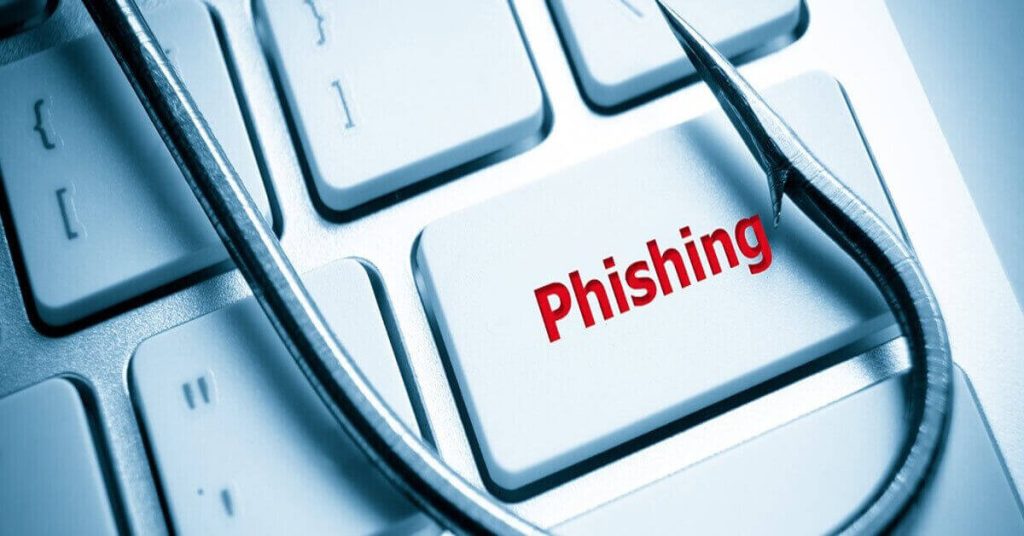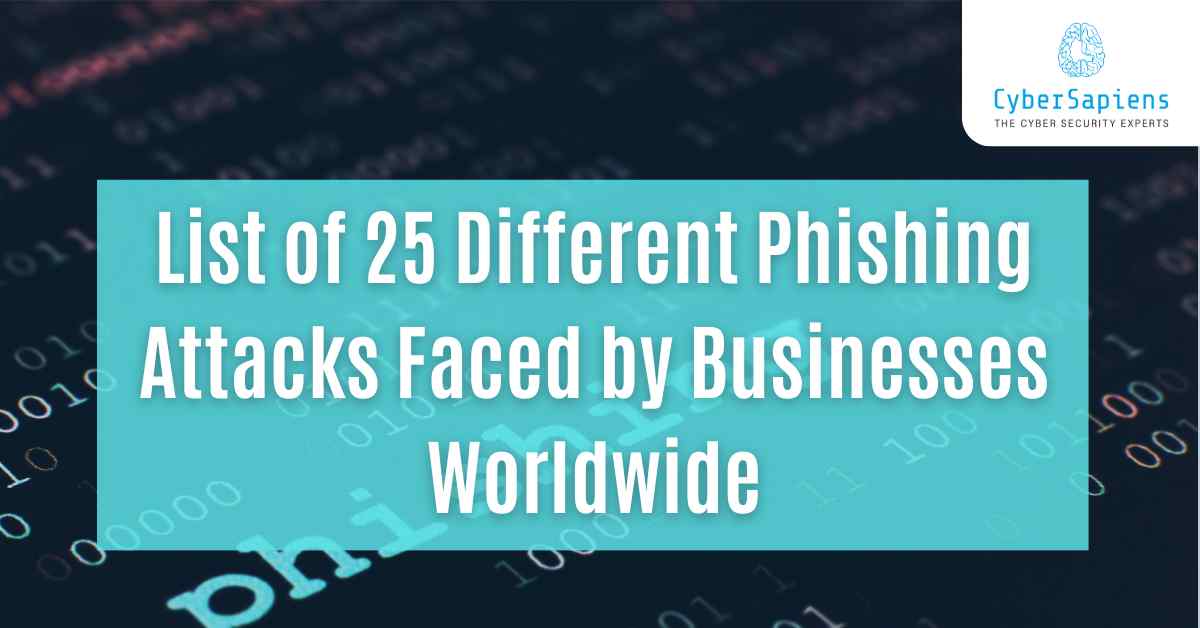Phishing attacks have become a serious threat to businesses worldwide, causing financial loss, data damage and reputational damage. These attacks take many forms and are constantly evolving, making it important for organizations to remain informed and vigilant.
In this article, we’ll explore the list of 25 different phishing attacks faced by businesses worldwide, along with prevention strategies and FAQs to help you better understand and combat these threats.
What are Phishing Attacks?

Phishing is a type of cybercrime in which individuals are tricked into revealing sensitive information or taking actions in favour of the attacker.
These attacks usually manifest as legitimate communications, such as email, text messages, or phone calls, such as from popular sources such as banks, e-commerce platforms, and even colleagues The primary goal of phishing attacks is to exploit human weaknesses such as curiosity, fear or urgency
List of 25 Different Types of Phishing Attacks

So, guys, we have done some digging and put together a list of 25 different types of phishing attacks.
We have researched each one to give you a clear picture of the threats out there. Let’s get started.
1. Email Phishing:
Typical Phishing, in which attackers send fraudulent emails to steal information or inject malware. These fraudulent emails often contain links to fake websites or malicious attachments.
It’s crucial to be cautious and verify the legitimacy of any unexpected emails, especially those requesting personal information or urgent action.
2. Spear phishing:
Attacks targeted at specific individuals or organizations, use personal information to gain credibility. The attackers gather information about their targets to make the emails more convincing.
These deceptive emails often contain personalized details, such as the recipient’s name, job title, or company, to increase the likelihood of success. Vigilance and caution are essential to avoid falling victim to spear phishing attempts.
3. Whale attacks:
A highly targeted spear phishing attack against senior executives or individuals such as executives or business leaders, within an organization. Here are the key points about whale attacks:
Targeted Individuals: Whale attacks focus on specific individuals who hold significant authority or have access to critical company resources. These targets are often decision-makers, CEOs, CFOs, or other top-level executives.
Objective: The goal of a whale attack is to deceive the target into taking actions that benefit the attacker. These actions may include transferring funds, disclosing sensitive information, or compromising security protocols.
Methods:
Email Impersonation: Attackers send convincing emails that appear to come from a trusted source, such as a colleague, business partner, or even the CEO. These emails often request urgent action or sensitive information.
Social Engineering: Whale attacks rely on social engineering techniques to manipulate the target’s emotions, trust, or sense of urgency. The attacker may create a sense of urgency (e.g., an urgent financial transaction) or exploit personal relationships.
4. Smishing:
Phishing attacks are carried out via SMS messages, often disguised as bank alerts or promotional offers.
5. Vishing:
Voice-based phishing attacks use phone calls to trick victims into sharing sensitive information.
6. Clone Phishing:
Sending a modified version of a previously received legitimate email with a malicious attachment or link.
7. Angler Phishing:
Attacks on social media platforms, where attackers impersonate customer support to interact with victims.
8. CEO Fraud:
Attempts to deceive employees into transferring funds or providing sensitive information by posing as the CEO or a high-ranking executive.
9. Search Phishing:
Exploiting search engine results to redirect users to phishing websites.
10. Drive-by Phishing:
Infecting legitimate websites with malicious code to steal information or install malware.
11. Malware Phishing:
Attacks that combine phishing tactics with malware distribution to gain unauthorized access or steal data.
12. Pretexting:
Creating a fake scenario to trick victims into revealing sensitive information, such as passwords or financial details.
13. Keyloggers:
Malicious software that records every keystroke on an infected device, capturing login credentials and other sensitive data.
14. Pharming:
Redirecting users to fake websites by manipulating DNS records, making it appear as if they’ve visited a legitimate site.
15. Domain Spoofing:
Using a similar domain name to a legitimate website to deceive users into providing personal or financial information.
16. Dropbox Phishing:
Using a legitimate service like Dropbox to distribute malware or steal credentials by posing as a Dropbox notification.
17. Invoice Phishing:
Sending fake invoices or billing statements to trick victims into revealing financial information or making unauthorized payments.
18. Calendar Phishing:
Manipulating calendar invites to distribute malware or steal information by appearing as a legitimate event.
19. Event Phishing:
Exploiting popular events or holidays to create a sense of urgency and trick users into sharing sensitive information.
20. Charity Phishing:
Taking advantage of people’s generosity during disasters or emergencies to solicit donations or steal information.
21. Social Media Phishing:
Using social media platforms to distribute phishing links or impersonate friends or public figures to gather sensitive data.
22. Social Engineering:
Manipulating people into divulging personal data or appearing actions that benefit the attacker.
23. Password Phishing:
Attempting to scouse borrow login credentials via posing as a valid internet site or provider and asking customers to update or confirm their passwords.
24. Ransomware Phishing:
Infecting gadgets with ransomware with the aid of tricking users into establishing malicious attachments or clicking on malicious links.
25. Watering Hole Attacks:
Infecting websites frequented by means of a specific target organization with malware to thieve data or advantage unauthorized get admission to.
LEARN MORE: Types of Phishing Attacks & How to Prevent Against Them
Preventive Measures and Best Practices to follow to protect your business from Phishing Attacks

1. Employee Education:
Train employees to recognize and report phishing tries, emphasizing the significance of vigilance.
2. Multi-Factor Authentication:
Implementing additional authentication methods to secure user debts and save you unauthorized get right of entry.
3. Regular Software Updates:
Ensuring all software programs, inclusive of antivirus and firewalls, are up to date to shield in opposition to recognized vulnerabilities.
4. Strong Passwords:
Encouraging using complex and unique passwords for each account.
5. Email Filtering:
Deploying electronic mail filters to detect and block suspicious messages before reaching users’ inboxes.
6. Incident Response Plan:
Developing a complete plan to handle phishing incidents, together with containment, research, and restoration.
7. Regular Security Audits:
Conducting periodic tests to identify capacity vulnerabilities and improve safety posture.
8. Data Backup:
Regularly backing up vital facts to limit the impact of facts loss because of phishing assaults.
Summary
Here is the summary of the blog titled “List of 25 Different Phishing Attacks Faced by Businesses Worldwide“
- Email Phishing
- Spear phishing
- Whale attacks
- Smishing
- Vishing
- Clone Phishing
- Angler Phishing
- CEO Fraud
- Search Phishing
- Drive-by Phishing
- Malware Phishing
- Pretexting
- Keyloggers
- Pharming
- Domain Spoofing
- Dropbox Phishing
- Invoice Phishing
- Calendar Phishing
- Event Phishing
- Charity Phishing
- Social Media Phishing
- Social Engineering
- Password Phishing
- Ransomware Phishing
- Watering Hole Attacks
Conclusion: List of 25 Different Phishing Attacks Faced by Businesses Worldwide
Phishing attacks continue to pose a significant threat to businesses worldwide, with new and sophisticated techniques emerging regularly.
By understanding the various types of phishing attacks and implementing robust preventive measures, organizations can significantly reduce the risk of falling victim to this cybercrime.
It is crucial for businesses to prioritize employee education, maintain a strong security posture, and stay vigilant in the ever-evolving landscape of phishing threats.
FAQ’s
1. How can I identify a phishing email?
Ans. Look for suspicious sender addresses, urgent or threatening language, and requests for personal or financial information.
2. Can phishing attacks target mobile devices?
Ans. Yes, phishing attacks can be carried out via SMS, phone calls, or malicious apps, targeting mobile devices.
3. What should I do if I suspect a phishing attack?
Ans. Report the incident to your IT department or service provider and avoid clicking on any links or providing sensitive information.
4. Are phishing attacks only limited to emails?
Ans. No, phishing attacks can occur through various channels, including text messages, phone calls, and social media platforms.
5. How can I protect myself from phishing attacks on social media?
Ans. Be cautious about clicking on links or downloading attachments from unknown sources, and verify the authenticity of requests for personal information.
6. What is smishing?
Ans. Smishing refers to SMS-based phishing attacks.
7. What is whaling?
Ans. Whaling targets high-profile individuals, such as CEOs.












